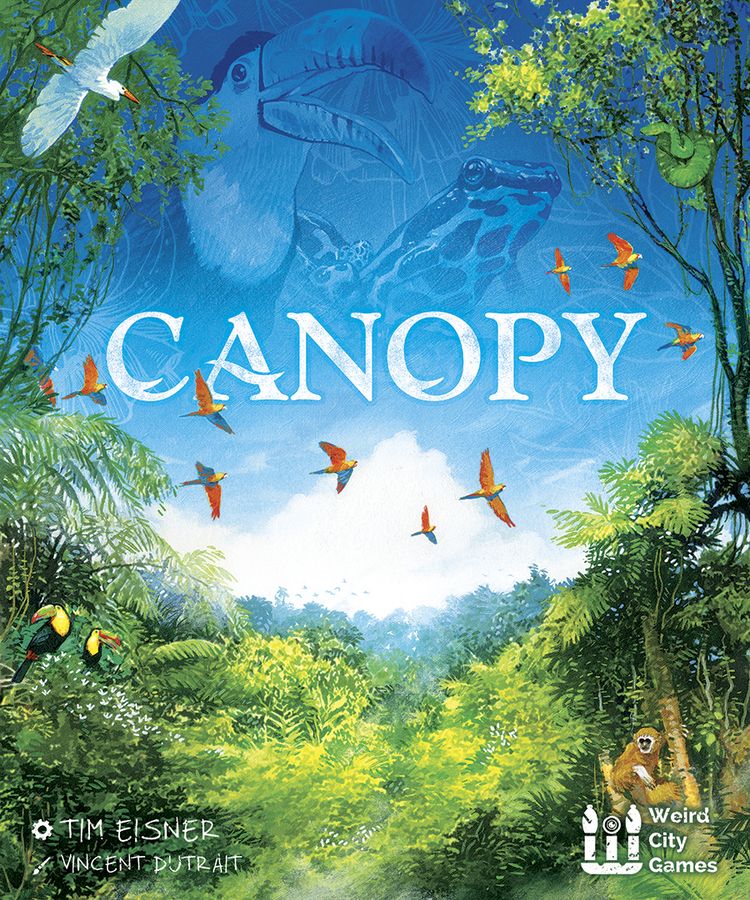The word canopy conjures up three images for me. Parachutes, rainforests, and misheard hors d’ouevres. Canopy in this instance is about the one in the middle – rainforests. It’s a two-player card game of developing your own patch of rainforest, growing plants and trees, attracting wildlife, and dealing with the inevitable outbreaks of fire and disease.
I’m going to kick-off this review by saying that Canopy is gorgeous. I know, I know, the art doesn’t matter if the game is great (looking at you here, Gaia Project), but the rainforest is meant to be beautiful, and full of colour. Artist Vincent Dutrait has done a fantastic job of recreating the hues and romanticised imagery of the rainforest I was hoping to see. It’s a game of gradual tableau-building, but with a fantastic mechanism that’s new to me, and really appeals to that part of my brain that likes to push its luck.
Sneaky peeks
Between the players there’s a row of cards representing new growth. It’s a forest after all, stuff grows. Cards from the current season’s deck get placed into slots numbered 1-3 of the new growth, and then comes the fun. On your turn, you pick up all of the cards in slot one, decide if they complement what you’re going for, then either claim them and stop, or put them back down, and add an unseen card to the pile. Then you move onto the next pile, and do the same. It means there’s this wonderful situation that’s constantly playing out, whereby you know exactly what the other player is going to pick up if you pass, plus an extra card. But what if that extra card I haven’t seen is amazing?!

This pick-or-pass mechanism is great, it adds a layer of tension, similar to getting to 16 in a hand of Blackjack having to decide whether to stick or twist. Fortune favours the brave… or does it? I really enjoy this method of drafting cards into my own little rainforest, the choice of what I include or exclude feels very personal. It means that whether I do well or not depends on how well I choose my cards, how much attention I’m paying to my opponent, and this little bit of chance from the unseen cards. I hate pure luck determining a game, and I don’t always like perfect information in games, as it can lead to a lot of AP. Canopy has the perfect blend.
The best laid plans
Most of the scoring opportunities in Canopy are constructed around future planning. Different plants have very different scoring mechanisms, and the creatures you bring to your jungle paradise don’t get scored until the third, and final, round. Your tableau of cards is there on the table, so the other player can see exactly what you’re trying to score with. This can lead to something I really like in games – being forced to take the least-worst option.
It tends to happen towards the end of a season, when both players have a good idea of what’s left on the table, waiting to be claimed. Take the beautiful Bromelia for example. Having two of them in front of you scores you 7 VPs. If you take a third, however, it’s now worth -3 instead, and your opponent knows it. The same applies with things like the fire cards. Having two of them is bad news for you, and you’ll lose two plants. Stoke that fire with a third card though, and you both lose one card instead.

Canopy is stuffed full of tricky decisions like this the whole way through. Nothing that can completely swing the game with a solitary card, but you need to build in plenty of mitigation for when your opponent forces you to pick up something you didn’t want. There’s this constant back and forth which is really engaging, and a lot of fun. Intermediate scoring after the first two rounds means you don’t get to the end of the game with no idea how well you did, in the way games like Concordia spring it on you.
Final thoughts
I’ve got a carefully curated collection of two-player games. The majority of the time I get to play a game, it’s with one other person, so I want the experience to be as much fun as possible. I’ve added Canopy to the collection, because it’s a great game which feels different to most of the others it now sits alongside (my favourite two-player games are here by the way).

For a two-player card game, it takes up quite a bit of space on the table, but that’s no bad thing, as it looks gorgeous. The rules are really simple to understand, the game moves fast, and it all (just about) fits in a really small box. If you enjoy it, I’d recommend sleeving the cards. There’s a lot of shuffling during setup, and the majority of the game revolves around picking some cards up off the table, looking at them, putting them back down, then repeating with the next pile. The cardstock is really good, but I can imagine it could start to wear after a while.
I normally like to add some caveats in my reviews, because not every game is for everyone, but I’m finding it hard to really come up with any for Canopy. It’s a game you’ll be able to pick up for a shade over £20, it’s got a ton of different cards, plays out in half an hour, and I’m honestly not sure who could find the theme offensive. Maybe if you got savaged by a tree frog as a child or something? Tim Eisner has put together a cracking little game in Canopy, that I have no hesitation in recommending.
Review copy kindly provided by Weird City Games. Thoughts and opinions are my own.

Canopy (2021)
Designer: Tim Eisner
Publisher: Weird City Games
Art: Vincent Dutrait
Players: 2
Playing time: 30 mins
